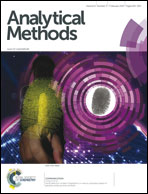Preparation of paper micro-fluidic devices used in bio-assay based on drop-on-demand wax droplet generation†
Abstract
Paper microfluidic devices are a promising technology in developing analytical devices for point-of-care diagnosis in the developing world. This article describes a simple method for paper microfluidic devices based on a PZT drop-on-demand droplet generator. Wax was jetted in the form of droplet, linked with each other and formed into wax pattern on filter paper with a PZT actuator and a glass nozzle. The heated wax pattern became a hydrophobic barrier for reagent used in bio-assay. The glass nozzle fabricated by a home-made micronozzle puller without complicated fabrication technology was low cost, simple and easily made. Coefficient of variation of the jetted wax droplet diameter was 4.0% which showed good reproducibility. The width of wax line was experimentally studied by changing the driving voltage, nozzle diameters and degree of overlapping. The wax line with width of 700–1700 μm was prepared for paper based microfluidic devices. Multi-assay of glucose, protein and pH and 3 × 3 arrays of glucose, protein and pH assay were realized with the prepared paper microfluidic devices. The wax droplet generating system supplied a low-cost, simple, easy-to-use and fast fabrication method for paper microfluidic devices.


 Please wait while we load your content...
Please wait while we load your content...